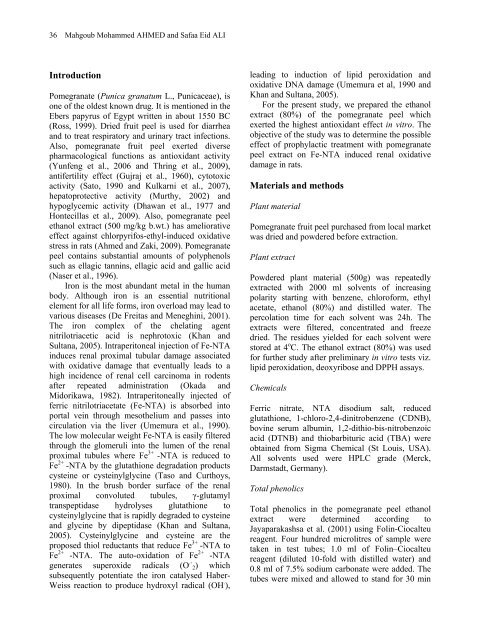Protective effect of pomegranate peel ethanol extract against ferric ...
Protective effect of pomegranate peel ethanol extract against ferric ...
Protective effect of pomegranate peel ethanol extract against ferric ...
You also want an ePaper? Increase the reach of your titles
YUMPU automatically turns print PDFs into web optimized ePapers that Google loves.
36<br />
Mahgoub Mohammed AHMED and Safaa Eid ALI<br />
Introduction<br />
Pomegranate (Punica granatum L., Punicaceae), is<br />
one <strong>of</strong> the oldest known drug. It is mentioned in the<br />
Ebers papyrus <strong>of</strong> Egypt written in about 1550 BC<br />
(Ross, 1999). Dried fruit <strong>peel</strong> is used for diarrhea<br />
and to treat respiratory and urinary tract infections.<br />
Also, <strong>pomegranate</strong> fruit <strong>peel</strong> exerted diverse<br />
pharmacological functions as antioxidant activity<br />
(Yunfeng et al., 2006 and Thring et al., 2009),<br />
antifertility <strong>effect</strong> (Gujraj et al., 1960), cytotoxic<br />
activity (Sato, 1990 and Kulkarni et al., 2007),<br />
hepatoprotective activity (Murthy, 2002) and<br />
hypoglycemic activity (Dhawan et al., 1977 and<br />
Hontecillas et al., 2009). Also, <strong>pomegranate</strong> <strong>peel</strong><br />
<strong>ethanol</strong> <strong>extract</strong> (500 mg/kg b.wt.) has ameliorative<br />
<strong>effect</strong> <strong>against</strong> chlorpyrifos-ethyl-induced oxidative<br />
stress in rats (Ahmed and Zaki, 2009). Pomegranate<br />
<strong>peel</strong> contains substantial amounts <strong>of</strong> polyphenols<br />
such as ellagic tannins, ellagic acid and gallic acid<br />
(Naser et al., 1996).<br />
Iron is the most abundant metal in the human<br />
body. Although iron is an essential nutritional<br />
element for all life forms, iron overload may lead to<br />
various diseases (De Freitas and Meneghini, 2001).<br />
The iron complex <strong>of</strong> the chelating agent<br />
nitrilotriacetic acid is nephrotoxic (Khan and<br />
Sultana, 2005). Intraperitoneal injection <strong>of</strong> Fe-NTA<br />
induces renal proximal tubular damage associated<br />
with oxidative damage that eventually leads to a<br />
high incidence <strong>of</strong> renal cell carcinoma in rodents<br />
after repeated administration (Okada and<br />
Midorikawa, 1982). Intraperitoneally injected <strong>of</strong><br />
<strong>ferric</strong> nitrilotriacetate (Fe-NTA) is absorbed into<br />
portal vein through mesothelium and passes into<br />
circulation via the liver (Umemura et al., 1990).<br />
The low molecular weight Fe-NTA is easily filtered<br />
through the glomeruli into the lumen <strong>of</strong> the renal<br />
proximal tubules where Fe 3+ -NTA is reduced to<br />
Fe 2+ -NTA by the glutathione degradation products<br />
cysteine or cysteinylglycine (Taso and Curthoys,<br />
1980). In the brush border surface <strong>of</strong> the renal<br />
proximal convoluted tubules, γ-glutamyl<br />
transpeptidase hydrolyses glutathione to<br />
cysteinylglycine that is rapidly degraded to cysteine<br />
and glycine by dipeptidase (Khan and Sultana,<br />
2005). Cysteinylglycine and cysteine are the<br />
proposed thiol reductants that reduce Fe 3+ -NTA to<br />
Fe 2+ -NTA. The auto-oxidation <strong>of</strong> Fe 2+ -NTA<br />
generates superoxide radicals (O .- 2) which<br />
subsequently potentiate the iron catalysed Haber-<br />
Weiss reaction to produce hydroxyl radical (OH . ),<br />
leading to induction <strong>of</strong> lipid peroxidation and<br />
oxidative DNA damage (Umemura et al, 1990 and<br />
Khan and Sultana, 2005).<br />
For the present study, we prepared the <strong>ethanol</strong><br />
<strong>extract</strong> (80%) <strong>of</strong> the <strong>pomegranate</strong> <strong>peel</strong> which<br />
exerted the highest antioxidant <strong>effect</strong> in vitro. The<br />
objective <strong>of</strong> the study was to determine the possible<br />
<strong>effect</strong> <strong>of</strong> prophylactic treatment with <strong>pomegranate</strong><br />
<strong>peel</strong> <strong>extract</strong> on Fe-NTA induced renal oxidative<br />
damage in rats.<br />
Materials and methods<br />
Plant material<br />
Pomegranate fruit <strong>peel</strong> purchased from local market<br />
was dried and powdered before <strong>extract</strong>ion.<br />
Plant <strong>extract</strong><br />
Powdered plant material (500g) was repeatedly<br />
<strong>extract</strong>ed with 2000 ml solvents <strong>of</strong> increasing<br />
polarity starting with benzene, chlor<strong>of</strong>orm, ethyl<br />
acetate, <strong>ethanol</strong> (80%) and distilled water. The<br />
percolation time for each solvent was 24h. The<br />
<strong>extract</strong>s were filtered, concentrated and freeze<br />
dried. The residues yielded for each solvent were<br />
stored at 4 o C. The <strong>ethanol</strong> <strong>extract</strong> (80%) was used<br />
for further study after preliminary in vitro tests viz.<br />
lipid peroxidation, deoxyribose and DPPH assays.<br />
Chemicals<br />
Ferric nitrate, NTA disodium salt, reduced<br />
glutathione, 1-chloro-2,4-dinitrobenzene (CDNB),<br />
bovine serum albumin, 1,2-dithio-bis-nitrobenzoic<br />
acid (DTNB) and thiobarbituric acid (TBA) were<br />
obtained from Sigma Chemical (St Louis, USA).<br />
All solvents used were HPLC grade (Merck,<br />
Darmstadt, Germany).<br />
Total phenolics<br />
Total phenolics in the <strong>pomegranate</strong> <strong>peel</strong> <strong>ethanol</strong><br />
<strong>extract</strong> were determined according to<br />
Jayaparakashsa et al. (2001) using Folin-Ciocalteu<br />
reagent. Four hundred microlitres <strong>of</strong> sample were<br />
taken in test tubes; 1.0 ml <strong>of</strong> Folin–Ciocalteu<br />
reagent (diluted 10-fold with distilled water) and<br />
0.8 ml <strong>of</strong> 7.5% sodium carbonate were added. The<br />
tubes were mixed and allowed to stand for 30 min
















